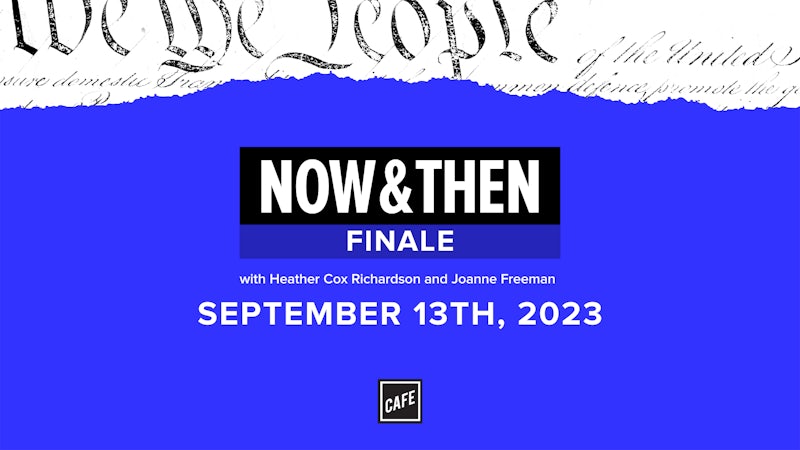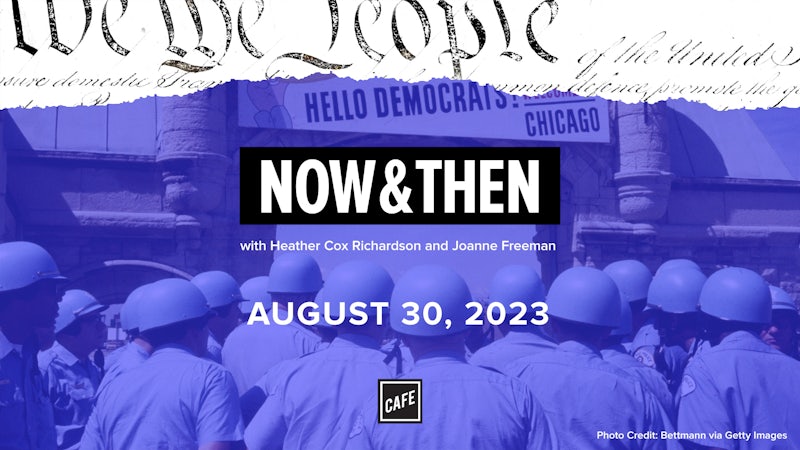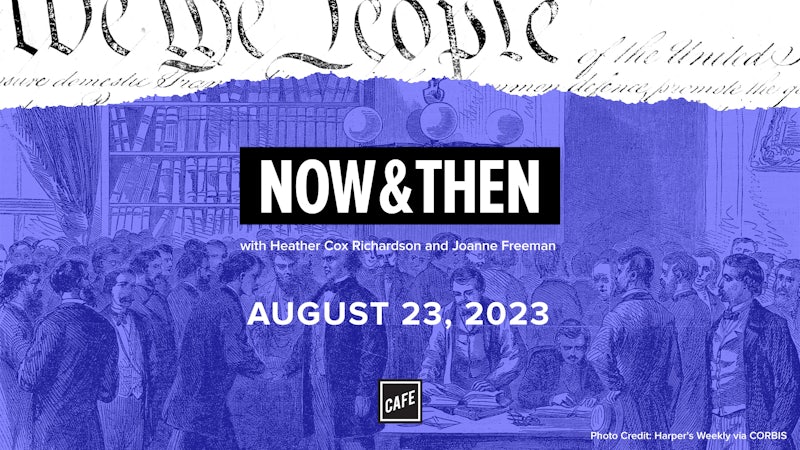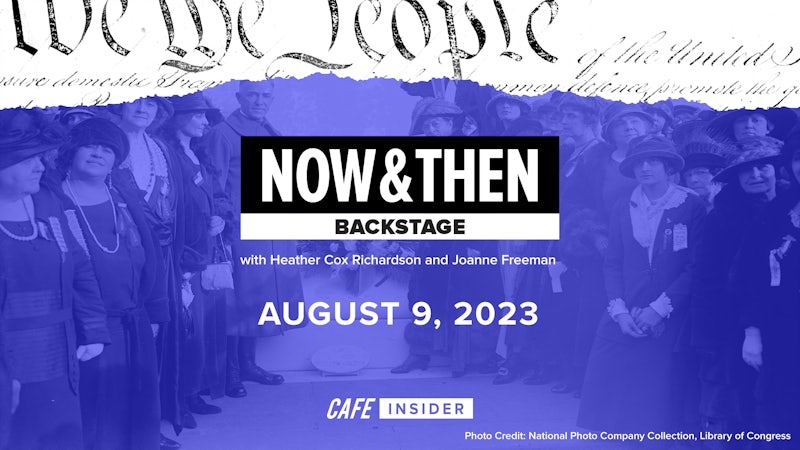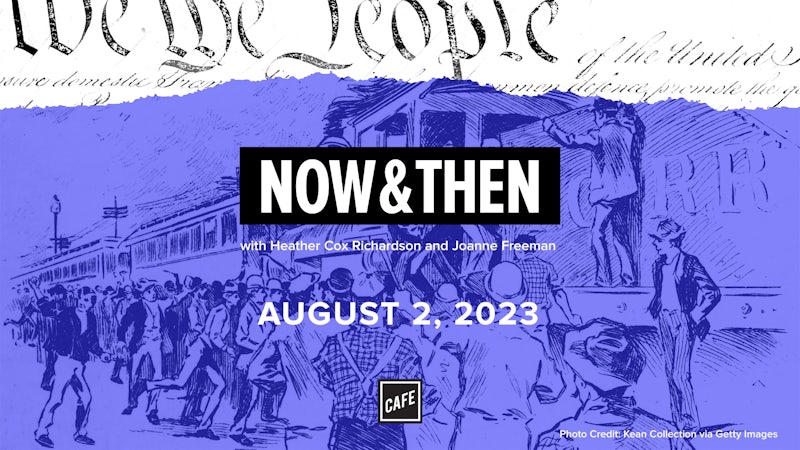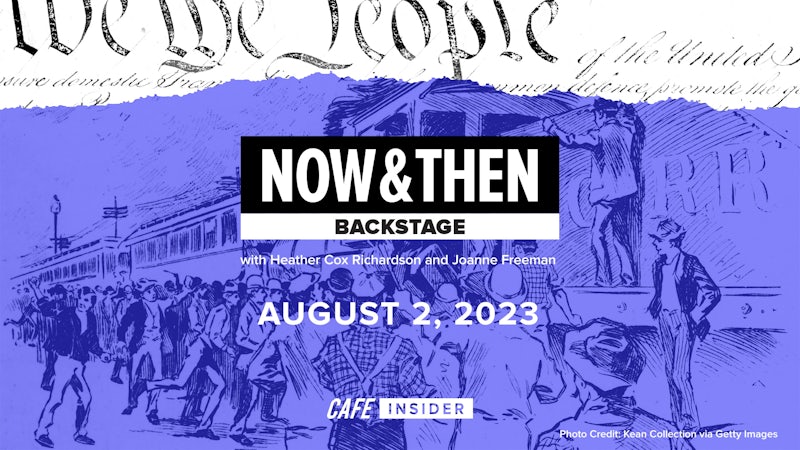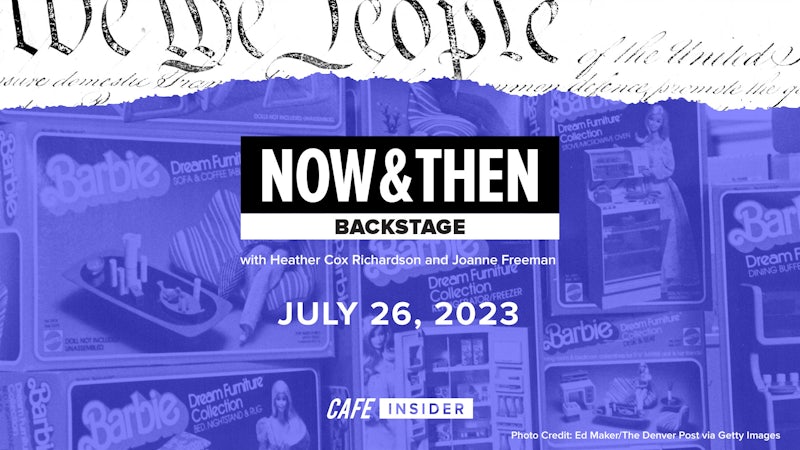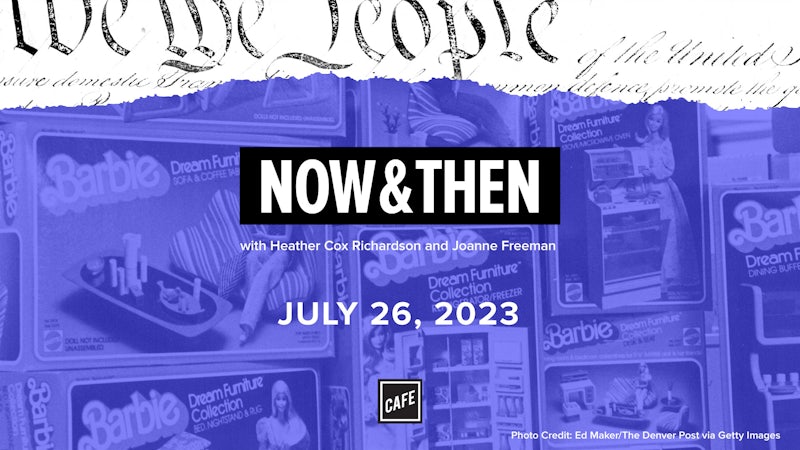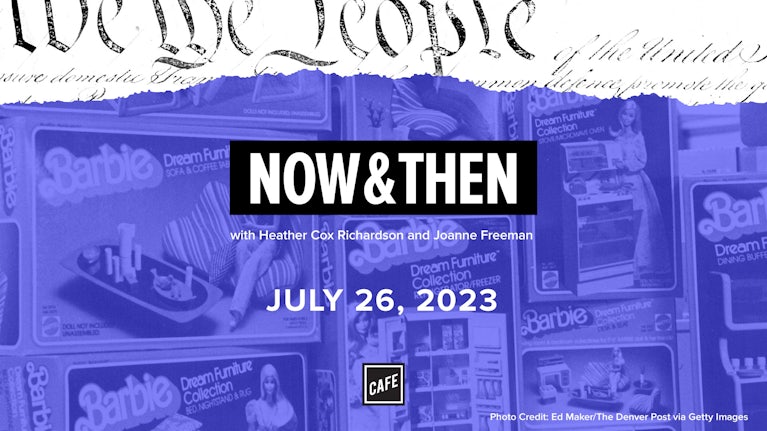Heather Cox Richardson:
From CAFE and the Vox Media Podcast Network, this is Now & Then. I’m Heather Cox Richardson.
Joanne Freeman:
And I’m Joanne Freeman. We first thought of the topic for this episode in response to two recent horrific back-to-back shootings in California in January. The first was in Monterey Park, the other was in Half Moon Bay, and at least 19 people were killed and 10 injured in the attacks. Both of the shooters and the majority of the victims were members of the Asian American Pacific Islander community. And of course that certainly raised a conversation that raised topics that we’ve certainly discussed here before about violence and identity and the troubles facing the Asian American community.
Now it’s not as though pointing to thinking about analyzing the Asian American community and their influence in America is something new. In recent years, there has been a remarkable rise in hate crimes against the Asian American community. The Center for the Study of Hate and Extremism in 2021 said that anti-Asian hate crime increased by 339% in 2021. There’s been a huge surge. So for all of these reasons, today we want to talk about the Asian American experience throughout American history. And to do so, we’re very pleased to be joined by my Yale colleague, Mary Lui. She is a professor of American Studies and history whose work has focused on, among other things, Asian American history, urban history, and gender studies. She’s also the author of the The Chinatown Trunk Mystery: Murder, Miscegenation, and Other Dangerous Encounters in Turn-of-the-Century New York City. Mary, welcome to the show.
Mary Lui:
Thank you for having me.
Heather Cox Richardson:
It’s such a pleasure to have you here.
Mary Lui:
Well, it’s really wonderful and I’m sad that this is the occasion that we’re coming together, but it is such an important topic, so I am thrilled to be here.
Heather Cox Richardson:
And boy, do we have questions for you.
Mary Lui:
I’m ready.
Heather Cox Richardson:
So why don’t we start with a little bit about what Monterey Park and Half Moon Bay in a very general way can tell us about this amorphous group that we tend to call Asian American and Pacific Islanders?
Mary Lui:
Well, that’s a big question to start. They’re both places in California, but these communities are quite different from one another. In terms of what we’ve read in the media for sure, we understand Monterey Park to be middle class, upper middle class, suburban Asian and Latino dominated community outside of Los Angeles. It’s part of the San Gabriel Valley, which has seen a lot of immigration and settlement post 1965, post 1980s actually, in terms of the spreading out of Asian and Latino immigrants who’ve bought property, who’ve set up businesses, who’ve really transformed that area since 1965. The Half Moon Bay area is also heavily Asian Latino, but from what I understand in terms of the location that that’s more rural, we see a lot more farm laborers, completely different socioeconomic class of farm laborers, migrant laborers. And so quite different, even though we’re talking about the same state.
Heather Cox Richardson:
When you think then about Asian Americans, it’s not a monolithic group.
Mary Lui:
No, definitely not a monolithic group, yes. If we take Monterey Park for a moment, the move of Asian immigrants into that area, we’re seeing Chinese immigrants, we’re seeing Koreans, Vietnamese. It’s very complex in terms of what we are talking about. And a lot of that really has to do with the changes in immigration law after 1965, and of course the end of the Vietnam War in terms of Southeast Asian refugee migrations and resettlement. So in ’65 we get this big change where we see the move from origins quotas into hemispheric quotas. And so as a result we see the significant rise of Asian immigration. Also, it’s the first time that we’re seeing family reunification categories that allow for Asian Americans who are in the US already to petition and bring family members who had been not able to come during the exclusion era. So with the rise of family reunification and then also the professional categories, this is the third preference category, which also makes a huge difference, which is why we suddenly see this big change in terms of the socioeconomic background of Asian immigrants coming through.
So we’re seeing professionals in terms of doctors, nurses, engineers, scientists, basically all coming through that category who may or may not have relatives already here in the United States. So we’re beginning to see this really dramatic diversity in terms of socioeconomic class from continuing to see laborers migrating, all the way up to professionals and entrepreneurs, who really bringing with them the capital to start new businesses.
Joanne Freeman:
So just to reiterate what you just said, because the word diversity obviously is key to everything that you just said, Mary. One of the things that we certainly want folks listening to think about is that the term Asian American is a huge umbrella term that covers over all kinds of diversity, the kind that you just described, and also named as some of the groups of people who end up getting put under that demographic category of Asian American.
Mary Lui:
Yes, definitely. And I would say the thing to also keep in mind is when we have a term like Asian American, it sort of assumes Asians of all ethnicities or countries of origin are coming into the United States and therefore Asian American. But if we actually look at the history of the United States in terms of its immigration laws and then also in terms of its imperial ventures overseas, you really begin to see how the label Asian American is not quite as expansive as we might imagine, or at least there’s a history behind who all these people are.
So we can think about Chinese immigration coming in as early as the mid 19th century as part of the gold rush, but as Chinese are excluded, you see the next group that capitalists are looking for in terms of helping to build the West out or in Hawaii in terms of building out sugar plantations. You see Japanese coming in. And then when Japanese migrants are banned after 1907, ’08, then you see the turn towards South Asians who are basically coming through until about 1917, the Asiatic Barred Zone Act. And then you see the move to Filipinos who are basically at that point not considered Asian immigrants, but American nationals because of the US colonial conquests of the Philippines. So that begins to help us understand why there’s certain groups in the United States rather than when we say the term Asian Americans as though every single Asian country is sending their people equally.
Heather Cox Richardson:
So on that note, that’s a great transition back to the world of early America. What is the history of early America, first conceiving of what a relationship with Asia might look like?
Mary Lui:
One of the things that I say to my class, my students is we have to imagine all the way back to 1492 actually for a second if you don’t mind, because after all, what the heck were these people doing trying to sail across the oceans? Well, they were trying to find roots to Asia, trade routes, faster routes. So one could argue that the relationship in terms of North America to Asia goes all the way back to these moments. Of course, we’re not seeing mass migrations of Asians at this point, but I think it’s actually important to keep that in mind. That there was always sense of this economic urgency and possibility that is bringing people to think about Asia, even in places like North America in this early period.
Heather Cox Richardson:
They’re looking for trade of course, but what you’re saying suggests that they’re also imagining what Asia might look like because it’s hard to imagine… I mean certainly the sailors would have had some experience with people from other countries, but people sitting back home in Europe probably were just imagining what Asia might look like and people who live in Asia might look like. Is that right?
Mary Lui:
Oh yeah. I mean, we have a long history of these trade routes, whether they’re overland with terms of like Marco Polo and those folks or by sea through the Levant. I mean, people are bringing back stories of what they’re encountering in the so-called Eastern Orient for a very long time. I think so much so that it makes sense that someone like Columbus would stumble across indigenous people and assume they were in India, that they are in the Indies, and therefore people are called Indians for this very reason. And you go into his writings, he continues to imagine this for quite some time. This is not something he realizes after his first voyage that he’s made a mistake.
Joanne Freeman:
I want to bring something up at this point because it has to do with what you’ve just talked about, Mary, which is you talked about the early, early roots of how people were imagining Asia and China, particularly India. But in early America, first in the colonies and then in the very first years when America was a country, China initially as a place that was providing goods that were considered to be luxuries and status symbols. People wanted to own Chinese porcelain. That was a big deal. And you can see in all kinds of accounts when you read of early Americans, they’re tracking, they want it, they have it. Who has it? What does it look like? So initially, economically, and really in a sense, I guess you could also say as far as colonial identity goes, China certainly was entangled with how Americans were thinking about themselves.
But what’s really interesting to me is that within months of the Continental Congress ratifying the Treaty of Paris, the new United States, 1783, 1784, realizes that Great Britain, now that we’re a separate country, Great Britain is going to limit American contact with the West Indies. So suddenly America is facing trade limitations, but they’re really eager to then trade with China because… And there’s a fascinating quote from John Adams from 1783, and he says to the Continental Congress, “Send ships immediately to China. The trade is as open to us as to any nation.” So Americans turn to China in a way because they say, “Oh, look, they’re going to treat us as equals to any other country. So this is great.” And it’s 1784, is the first American ship that is sent to China to bring back goods.
So just as you’re saying, we need to broaden our timeframe, we need to broaden our geographic frame because I think people think of early America and an Atlantic frame, and we’re broadening that a lot, even just in what we’ve discussed so far as far as early America goes.
Mary Lui:
Yes, I 100% agree. And it’s in 1784 is a fascinating moment where you have the Empress of China setting sail from New York City on its way to China, hoping to really fill the coffers of the new nation in terms of what it’s bringing. And there’s a huge question of what the Chinese want. There’s of course money, but ginseng is this root that they’re hoping is going to really bring it in the markets. Furs is another one, but there’s all these things that they’re not quite sure because this is a new venture for the new nation. But New York’s not alone. Philadelphia is right behind. Other port cities are also trying to make it big with the same exact trade. Even here in New Haven, in our little local historical society, you see the things that they’re bringing back from the China trade. And up the coast in Boston, you see this. In Salem, Massachusetts, they’re making a bid to go towards India and Southeast Asia to Indonesia. They’re looking for the spice trade.
So you’re really seeing this opening up of trade possibilities, and as a result, you’re bringing in the goods. Porcelains are one, but also furniture is another one. We see fabrics, we see other kinds of metal work, but the kinds of artisanal industrial production that was possible in the colonies was extremely limited as a result. It’s understandable why porcelains were so prized. Here in the colonies it’s red wear, I believe was the popular pottery form. And if one sees red wear, it’s very rough. It’s clay, it doesn’t speak of finery and distinction in a sense of maturity for a new nation or it’s ruling class. So you can see why our founding fathers were so interested in trying to get porcelains back. T sets, dining sets, things with family cress. And the original, I believe, China that was purchased for state dinners were also from China just because it would be a little embarrassing to have these elaborate state dinners served on red wear. I would imagine it would really scream. We are just a bunch of-
Joanne Freeman:
Provincials.
Mary Lui:
Exactly, exactly.
Joanne Freeman:
But what’s wonderful about that is the way in which in a really tangible way, American identity is bound up with China and Asia generally from the very beginning. Again, this is something that I think doesn’t get on that many people’s radar screens when they’re studying early America, but I think as we’re going to be discussing today, we’re going to keep coming again and again and again to different moments in which Asian Americans are defining, characterizing, shaping what America is and how Americans think about what America is.
Heather Cox Richardson:
So I have to assume that because of this interest of the founders, the United States Congress was really eager to have all of these people become new American citizens, right?
Mary Lui:
If you look at the demographics, people have come from many different places. It’s important to think about how as these ships are coming and going through these ports, they’re setting sale with ginseng, with specie, which is silver species, which is basically money. And the question is, what are they coming back with? And they’re coming back with porcelains and furniture and cloth and spices. They’re also coming back with people, not a lot of people, but you’re seeing some sailors who are coming on board who are always been at this mobile laboring population on the oceans. And so in places like Salem and New York and Philadelphia, you’re seeing this sort of multicultural, multiracial grouping of people on the wards. And some of these people do actually decide to stay. We have people who’ve come along.
And even earlier than this moment of 1784, we do know that some indentured servants came through during the colonial period, especially coming out of India through London and then out across the ocean. Not many, but we see them here and there. But really beginning in 1784 and later, you begin to see people actually coming into the ports and settling in and they’re coming and going. They’re staying in boarding houses while they’re here and they leave. Some of them marry, some of them have children. So we have little records of them here and there through the census. A diary of a sea captain, for example, mentions the people who came on board with him and they intermarried with free Black women in the town of Salem and then basically became part of the Black population in that town. So in New York City, we know of Chinese who were in the Seaport District intermarried, and some really settled and raised families.
So the new nation is facing a big question of how do you turn all these different people across these 13 colonies to one nation and one people? And the question of course is resolved by granting citizenship. And in the moment of 1790, the rule of naturalization is debated by Congress, passed, and everyone who is “a free white person” is granted citizenship. And this makes sense in the moment of 1790 because you have this wide array of people coming from France, England, even Scandinavian countries. There’s Swedes in New Jersey. There’s all kinds of people all up and down the coast. And to use the phrase free white person seems to be a very simple solution of what to make of all of these folks coming from these different parts of Europe. However, it clearly is excluding many people from citizenship.
And at the time, even though we have tiny populations of Asians in these seaport districts, this is certainly not on the mind of Congress in terms of when they’re making the free white persons. They’re most concerned about how to create a sense of unity among the larger European folks who are in the colonies at the moment. But that said, once free white persons is embedded in the rule of naturalization, it does take on a very important legal life and activates in terms of really actively excluding many.
Joanne Freeman:
It’s worth noting that specifically because the United States brings these nation states together to create a country, and initially there’s different policies about people who can come in and people who can’t come in and different colonies and even still within states for a while, citizenship from the very beginning is an enormously complex and fraught and vitally important aspect of the new nation defining itself. And along the same lines from the very beginning, it becomes a vital way to include and exclude. So the 1790 Act is part of this larger, huge long conversation about who is a citizen and what does it mean to be a citizen, and what do you get for being a citizen?
Heather Cox Richardson:
I love the way this plays out in the middle of the 19th century because it becomes a huge issue after the California gold rush and gold is discovered in ’48 and then the people really start to pour in 1849. By 1882, there are more than a hundred thousand Chinese immigrants in the United States. And from the very beginning, if you think about California, the United States takes possession of the land that is now California after the signing of the Treaty of Guadalupe Hidalgo. Actually gold is discovered shortly before that. I think it’s 10 days before that, but they keep it under wraps until after the ink is dry. And then there’s this incredible rush of people from all over the world to California in ’49. By 1850, there’s so many people there, both Eastern politicians and people in the California area are desperate to make it become a state because it’s completely lawless essentially.
And one of the first things they do is they discriminate against Chinese immigrants saying, for example, that they can’t testify in court. They have to pay a foreign minors tax, by the way, which also covers Mexican people who were there for the gold rush, but who had actually been in their country of origin until the previous year. And that’s something that really, really concerns people like Abraham Lincoln and William Henry Seward who talk about the distinctions that people in California are beginning to make among different kinds of residents of California. And starting to say, wait a minute, we got ourselves a real problem here in terms of destroying the idea of equality before the law and setting aside categories for people like Chinese in California.
So that idea that there are different categories of people in America is central, of course, to the Chinese experience, but it’s also central to the way that people like William Henry Seward, who’s one of the leaders of the Republican Party, conceptualize the concept of equality. We always focus on how they’re looking at Black Americans, but they are also quite explicitly looking at Chinese in California. So all of this question of who’s allowed to be here really focuses a great deal on the gold rush and on the Chinese coming in because of the gold rush.
Mary Lui:
I would also say at the same exact time that we’re talking about California, the south is in play as well, the South and the Caribbean, and I just want to throw that part of the country into the conversation very quickly. Prior to the Civil War, planters are already quite concerned about what is going to happen to their labor supply. I think they have a sense that, especially with British emancipation, that basically slavery is not going to continue in the US. And the question of exactly when that will end, who was going to replace that plantation labor is something that is causing a lot of anxiety. And it’s also in the same period that because Chinese and Indians as well, were already brought into the British Caribbean colonies, they’re seeing experimentations with Asian labor to replace enslaved Black labor. So the south is looking at that.
And so we can look at the Memphis Convention of in the 1860s where they’re really talking about what is the possibility, and they’re looking to California because there are Chinese laborers who happen to be there in large supply, and they’re imagining, “Could we bring Chinese out from California into the south? Can we bring Chinese labor from the Caribbean into the south?” So these questions of exclusion and where Chinese fit I think also has to be understood within this kind of racial economics of where Black labor was in this moment as well. And then the concerns over the end of slavery and what would happen to the southern plantation economy, those are also bound up in these questions as much as the gold rush on the West oast in terms of the competition with white labor. So these are all kind of happening simultaneously.
And certainly once we end the Civil War, we get 1869 with the building of the Transcontinental Railroad. The question of Chinese labor then becoming something of concern of the entire nation really erupts as the country is brought into a deep depression and Chinese labor seem to be free to go and roam about the country and cause all kinds of local labor competitions.
Heather Cox Richardson:
So that’s a really cool moment because during the Civil War, the US Congress and the American people get really furious at Europe, especially at England for what they consider to be insufficient support for the United States. And the United States has put in place its first minister to China, Anson Burlingame, and he reappears in America in 1868, and maybe you’ll want to walk us through the slight of hand he performs in producing the Berlingame Treaty. But it is a treaty of agreement between the United States and China that is going to permit really quite free passage back and forth between the two continents for the simple reason that in that period… I mean, Berlingame is doing his own thing, and there’s all sorts of different congressional ideas, but the United States government is so angry at their European former partners that they’re willing to entertain the idea of a new Trans-Pacific partnership to orient the United States toward Asia, which they say is a much bigger market than Europe was at the time.
And it’s really interesting because that is signed in ’68 and there’s all kinds of parties all around the nation, and people seem to be terrifically excited about it. And then as you say, in ’69, with the completion of the Transcontinental Railroad, the railroad workers go back to the cities just as a depression hits. And almost instantly we start to see anti-Asian riots, murders, gangs attacking Asian Americans. And that’s when that free white persons as citizen thing really starts to have teeth in the late 19th century, because at that point, theoretically under the 14th Amendment, the admission to citizenship is going to open up really dramatically. But in fact, the western states that are right then writing their state constitutions, they say, “We’re not going to let in anybody who’s not a free white person.” And whoops, there go the Chinese; and whoops, there go the indigenous Americans. And after the 14th Amendment, we’re going to retain those same categories, which were the ones that off William Henry Seward in the first place.
Mary Lui:
Yes, the 14th Amendment is huge. Specifically this foreign on US soil business is really important, and it’ll come to play big time for allowing certain Asian Americans to finally have citizenship. The second generation born here in the US when Asian immigrants could not be naturalized. At least if their children were born in the US, under the 14th Amendment, they had citizenship. Only through the 14th amendment was that possible. So in 1870, we get another rule of naturalization that continues to uphold free white persons, but then makes an exception for people of African descent and African nativity. So that’s how free Blacks are able to claim citizenship through this particular amendment. So there is an important change in 1870, and one of the debates that we have in the field all the time is could Chinese have tried to petition through that little loophole and claim that they were similar to African Americans and gain citizenship that way. But all the citizenship cases we’ve seen basically do not go for that route, but instead try to challenge the notion of whiteness head on and fail.
Heather Cox Richardson:
Can you walk us through the Chinese Exclusion Act?
Mary Lui:
Sure. Most people are familiar, if they’re familiar at all, with Chinese exclusion with 1882. The provisions there initially was a 10-year ban on specifically Chinese laborers migrating to the United States. So exempted categories were created for merchants, diplomats, scholars, other folks in that category, basically people who were necessary for the purposes of US trade, economy and diplomacy. How laborers, because of the concern over labor competition, especially against white labor competition, basically was aimed at banning Chinese labor migration. Congress was supposed to vote again 10 years to see if they were interested in keeping it.
But it’s actually important to go back a few years earlier than 1882. I would actually go with the Page Act in 1875, where that particular act brought forth by Horace Page, Congressman from California, who had initially tried to ban Chinese migration to California but could not because states did not have the right to regulate immigration. Only the federal government did. Then put forth the Page Act, which specifically banned importation of contract laborers, coolie laborers, as well as women deemed to be of immoral background, prostitutes, et cetera. But that particular law was used very heavily against Chinese laborers and specifically Chinese women, even before we get to 1882.
So ’75 very much sets a lot of the terms that 82 will pick up, and 82 becomes a broader law, more set. And at that point, as I said, it was meant to be 10 years. Congress was hoping that that might appease white labor agitation, but instead we continue to see all sorts of violence. And I think the impact on Chinese laborers is really devastating because it really shows that Congress is willing to stand aside and say, “Anything can happen to you. We are not really interested in protecting your ability to be here in this country.”
Joanne Freeman:
It’s also worth noting what underlies everything that you just said, Mary, particularly at the end there, which is the nation basically says, “Yep, not on us.” The nation basically steps aside. If you’re talking about citizenship, that’s a really strong statement.
Mary Lui:
Yes, it’s quite profound. Initially the idea was that people who were here already could have the right to return if they were to leave the United States and go back to China and come back. But then in 1888, the United States goes back on that with the Scott Act. And so you have thousands of Chinese who are in China visiting family who had planned to come back stranded and cannot come back. So you’d see these changes along the way. And then after 10 years are up in 1892, we have the Geary Act, which renews Chinese exclusion and then adds on top of that all kinds of paper requirements, certificates of residents that have to be proven, certificates of entry that are used to then determine whether someone is here lawfully. And then they ask Chinese to register themselves if they were already here and not coming through the border. And you see mass protests actually.
So Chinese band together through the Chinese Consolidated Benevolent Association, sort of the mutual support group, the mutual associations that are here at the time, and they really tried to organize everyone and say, “Refuse, refuse. Do not show up to get registered because we’re basically legitimizing exclusion. Do not do it.” And it’s really only through rounding up threat of imprisonment, deportation, that the Chinese community has no choice but to acquiesce to those demands.
By 1904, Congress has voted to move Chinese exclusion into perpetuity. Forget that every 10 years, we all know the nation does not want Chinese laborers, is what basically Congress is saying. So we are in this mode, and as this is happening, Japanese immigration has been picking up to fill in the slack of Chinese immigration. And as a result, by 1907, 08, we have the Gentlemen’s Agreement between the United States and Japan to stop Japanese labor migration. It’s called the Gentlemen’s Agreement because Japan at the time was quite powerful, had defeated Russia in the Russo-Japanese War. And so it was a very different handling of labor exclusion in terms of the so-called Gentlemen’s Agreement as opposed to a federal ban against labor migration.
So as I said before, we have Indians, south Asians coming through to again pick up the slack because… It’s a fascinating sort of movement back and forth as you see Congress banning and then employers going out back into Asia, finding yet another labor supply to replace. And then we get into the 1917 Barred Zone Act, and basically at that point, Congress has decided it makes no sense to ban group by group. Instead, they’re literally drawing a map of the world and putting a line that passes between Europe and Asia and saying, “Everyone on the east of this line is banned,” which gets us to then 1924 in terms of the Johnson-Reed Act, where by this time it’s not simply Asian exclusion that they’re after, but really trying to turn the clock back to a so-called national origins moment of resetting the nation to encourage immigration from Western Europe and discourage immigration from other parts.
So the fascinating thing about 1924, however, is that you see so-called undesirable European immigrant groups are falling under a quota system, a very complicated algorithm, but Asians are just banned outright. They’re just excluded. So they’re in a very different category altogether. And then Filipinos are the only ones who are coming because of the relationship of Philippines to the United States as a colonial territory. This basically stays in place until we get into World War II, when the geopolitical necessity of creating Asian allies against the Japanese empire makes it imperative to end Chinese exclusion because it was frankly embarrassing. So in 1943, you see the repeal of Chinese exclusion, but that said, what happens then is that the Chinese end up having the same quota system applied to them that Europeans are under. So really we’re not really talking about the [inaudible 00:33:52] exclusion. There’s about 105 Chinese who are allowed to come every year.
’52, we get the McCarran-Walter Act in the middle of the Cold War. Again, trying to show a good faith effort towards our Asian allies in the Pacific. In between that, Philippines and India see their exclusions repealed as well. And things basically stay that way until 1965 with the changes in immigration laws at that point, this change of people coming in. ’65 is understood as this profound liberalization moment. It’s meant to be thought of as the civil rights ethos coming into immigration, but yet it’s actually quite a profound moment in the nation’s history in the mid, late ’60s. The US is engaged in the war in Vietnam, and it’s certainly dealing with all kinds of crises in its inner cities in terms of poverty, housing, employment. So we can see all of these things coming together and erupting in the late ’60s in places like Berkeley, California, Oakland, California, Los Angeles, New York City with Asian populations who are really protesting the war. They’re protesting the ongoing impoverished conditions of inner city populations of Asian immigrants who are coming in, overcrowded Chinatowns, little Tokyos, little Manilas that have been formed out of a history of exclusion and similarly defunded and under-resourced as the rest of the cities that they’re in.
Heather Cox Richardson:
There’s all these liberation movements in 1968. How does this play out in the Asian community, and who is the Asian community in America in this period?
Mary Lui:
So the Asian community in this period of 1968, it’s still very much the earlier generation of folks who were here during exclusion and their descendants. So the activist population, mostly what we’re seeing is that they are happening in places of universities where you have student activists that are meeting each other. They’re meeting each other in the classroom, they’re meeting each other on the streets and protests. Not surprising that Berkeley would be one of these places, or San Francisco state would be one of these places because of the location of a place like San Francisco and Berkeley in terms of having many student protests coming through. They’re not the only people, they’re also community people who’ve been struggling and pushing back against all kinds of repression over the years. But you have basically young students like Emma Gee and Yuji Ichioka who founded the Asian American Political Alliance and really worked with the Black Panthers and other student liberation organizations to really try to understand how US interventions in places like Vietnam are connected to problems of inner city underfunding, defunding and the lack of services.
Joanne Freeman:
Now, a lot of these groups come together in an organization.
Mary Lui:
Right. They’re all part of this umbrella of the Third World Liberation Front, which comes out of all of these different student groups deciding to come together and really protest much of the same thing. Of US imperialism in Vietnam in terms of the war, but also just overall what they’re seeing as a long history of policies that have perpetuated segregation.
Joanne Freeman:
It’s the richness of bringing all these people together in one way or another who intellectually and politically share a lot. I just love the idea of this one location, particularly fertile for what’s going on here and in the process of discovering each other, really having a lot to say, having an impact.
Mary Lui:
Yes, and I would say it’s a really important moment for Asian American activism, for the arts, just as much as for politics. The Kearny Street Workshop was located in a building that was the International Hotel, which was a location of extreme housing protests and labor protests, but they were in the basement and they were making art. They were a collective of artists doing their own work, but at the same time producing all kinds of art for the movement. They did the flyers, they did the posters, they got people out, they did the banners. And also, this is a moment…
When we use the phrase Asian American, we assume everyone had this label on them and welcomed it, but it’s really through this moment of ’68 and what preceded it that Chinese American activists, Japanese American activists, Filipino activists, et cetera, are really coming together and seeing like, “Oh, I can see how our experiences are shaped by this history of exclusion,” which played out differently for different groups at different moments in time, such as the Japanese were incarcerated during World War II, while other groups were not because they were embraced as allies of the United States. But nonetheless, going back, one can see how interment was very much connected to a longer history of exclusion.
Joanne Freeman:
So that history of exclusion, sort of counterintuitively ends up being something that brings people together, unifies them, and brings them together in a powerful way in the ’60s and the midst of this moment, or that’s happening on a lot of different fronts.
Heather Cox Richardson:
So can you walk us from that moment of the ’60s to the creation of the kinds of communities that we saw in Monterey Park, because the feel of what is identified now as the Asian American Pacific Islander community seems a world away in many ways from 1968.
Mary Lui:
I think going from there, what is important to understand is that ’68 does have this profound effect of opening up universities in terms of increasing student admissions. It basically creates more opportunities for more people. So by the time we start to see people coming through the 1965 immigration law provisions, especially the professional categories and the family unification categories, they’re coming into a very different United States from the exclusion era United States. So they’re coming to a United States that now has more opportunities for Asians than ever in the history of this nation, whether in terms of work, whether in terms of housing, education, it’s just a completely different landscape. And which is why oftentimes I think people don’t fully understand, especially if there are new arrivals to the United States, what this history had been. Because instead, if they’re coming in during the ’70s and ’80s, even with economic depression all around us or a recession around us, it’s a very different landscape of opportunity.
So from the ’70s onward, we begin to see very different migration patterns. So as I mentioned very briefly, the end of the Vietnam War brings in over 200,000, I believe, southeast Asian refugees in the first wave, and then subsequent waves, and then through family reunification, more people are coming through. We also see a huge rise in Korean immigration. A lot of that had to do with continued presence of the United States military in South Korea, and we see military bride migrations that then people turn to bring in their families and so on and so forth. And then Chinese immigration. And this time we’re not talking about Chinese immigration from basically one small part of China, Toisan, or Taishan, or Toishan if you’re Cantonese speaking in Southern China, but instead, you’re now seeing migration from many parts of China, Hong Kong, and Taiwan, as well as other parts of the diaspora, and money is coming.
So something like Monterey Park or the San Gabriel Valley really gets this rise of, as a result of Taiwanese migration and investment, and that attracts other middle class, upper middle class Chinese and others coming in. So over from ’80s onward, you really do see this dramatic transformation of the San Gabriel Valley, Monterey Park in particular, that really signals the success, the affluence of some of these new immigrants, but not without tension with the older, predominantly white residents who were in those communities prior to their arrival.
Joanne Freeman:
So Mary, there’s an ongoing problem or an ongoing dispute in California generally and in Monterey Park that kind of visually shows a lot of the tension that you’re talking about. So tell us a little bit about the signs of this controversy.
Mary Lui:
As the community really started to become increasingly more Asian American, especially Chinese American, Korean American, you begin to see businesses popping up. And Southern California is known for its strip mall landscapes. So as you pass by, you see these signs that are right on the street level with all bunch of different establishments that are along the strip mall. And what longtime white residents were noticing was that more and more of these signs were popping up, and they were Asian businesses, they were grocery stores, where the signs were mostly in the respective Asian language, and they found it very, very off-putting. So occasionally there would be English words with it, but overall, people start to object in the sense that this is not what Monterey Park should be. It’s turning into another Chinatown, is those are the kind of the things that you would hear in the ’80s and early ’90s.
And efforts to pass ordinances to maintain English language, we’ve seen those over time, and this was something that was hotly debated. There were efforts to pass different ordinances to do English language only, which did not come to pass, but continue to be debated, even as recently as just a few years ago. Most recently, they’ve moved away from English language, which perhaps had sort of a racist tinge to it, but instead the modern Latin alphabet to suggest something more universal or something that’s really more about the script itself rather than the politics behind these kinds of arguments.
Joanne Freeman:
So Mary, coming out of this conversation, where do you think this leaves us? What would you like to come out of this moment and this kind of awareness?
Mary Lui:
I think the final sentiment is to me, I hope Asian Americans will be visible in the country, not because of violence. Well, it’s great that we’re having this conversation now. I hope it will heighten the visibility of Asian American history, Asian American communities, and ongoing Asian American struggles in all facets of life in this country. Because I think what’s frustrating from what I’ve seen in the last few years is that the pandemic has pushed Asian Americans into this place of increased visibility, but not always for the right reasons. And to always be told that you’re a victimized community over and over again is difficult, and there’s so much more to say about Asian American life in history.
Joanne Freeman:
So Mary, thank you for that, putting that so beautifully. And thank you for being here for this conversation. We’ve been looking forward to this and it’s been wonderful to have you here informing us about this at this moment when particularly it’s in the limelight.
Heather Cox Richardson:
It’s been just wonderful to have you, Mary.
Mary Lui:
Thank you. It’s been the real pleasure. Thank you both.













